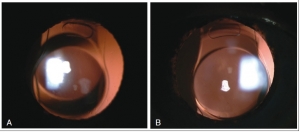 Autors: Fritz H. Hengerer; Pablo Artal; Thomas Kohnenl; Ina Conrad-Hengerer.
Autors: Fritz H. Hengerer; Pablo Artal; Thomas Kohnenl; Ina Conrad-Hengerer.
Journal: Journal of refractive surgery
Volume: 31 (3)
Pages: 158-162
Year: 2015
ISBN: 1081-597X
Abstract
PURPOSE: To evaluate the safety and efficacy of the iolAMD technology (London Eye Hospital Pharma, London, UK), which includes two injectable, hydrophobic acrylic intraocular lenses (IOLs) in a pilot study of patients diagnosed as having cataract and dry age-related macular degeneration.
METHODS: The cataract surgery and IOL implantation were performed after a preoperative evaluation using the iolAMD simulator in eyes with bilateral intermediate dry age-related macular degeneration. Outcomes were intraoperative and postoperative complications, subjective and objective visual acuity improvement, visual field changes, and postoperative diplopia.
RESULTS: Three eyes of 2 patients were evaluated. The surgeries were uneventful. All eyes gained monocular reading vision at the 1-week postoperative visit. One patient with monocular implantation recognized diplopia for distance vision. Preoperative corrected distance visual acuity ranged from 20/800 to 20/125 and corrected near visual acuity was 20/800 or less. Two months after surgery, corrected distance and near visual acuities increased to levels between 20/40 and 20/25 (uncorrected distance visual acuity was 20/60 to 20/32; uncorrected near visual acuity was 20/200 to 20/25).
CONCLUSIONS: These early results showed that the iolAMD simulator is a promising technology improving near and distance visual acuity in eyes with intermediate dry macular degeneration. The prismatic IOL effect did not lead to diplopia when implanted bilaterally. The surgery was safely performed.
Copyright © SLACK Incorporated
Download pdf: Initial Clinical Results of a New Telescopic IOL Implanted in Patients With Dry AgeRelated Macular Degeneration
Article’s Link: http://dx.doi.org/10.3928/1081597X-20150220-03
